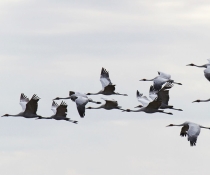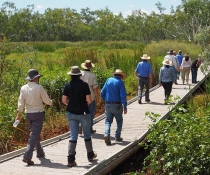Restoring animal habitat at a landscape scale
Annual autumn bird surveys in the Gwydir Wetlands have uncovered a diverse range of species, and not only the water-loving variety.

Scientists and environmental water managers from the Department of Climate Change, Energy, the Environment and Water recently conducted annual bird surveys in the Gwydir wetlands, 60 kilometres from Moree.
Twenty chestnut-breasted manikins were recorded at one survey site. A wetland edge specialist, the chestnut-breasted manikin is found in reed beds, long grasses, swamps and mangroves. The species feeds on grass seeds, usually on the stalk rather than from the ground.
NSW Wetlands and Rivers Conservation Officer David Preston said this highlights how water for the environment supports habitat for various animals beyond waterbirds.
'In addition to the 20 we saw during the surveys, I saw a flock of more than 100 recently in the transition zone from wetland to terrestrial habitat.' Mr Preston said.
'Waterbirds are not the only beneficiaries of water for the environment. Woodland birds, native fish, native plants, and trees all benefit from healthier waterways.
'Water for the environment is delivering habitat restoration and building resilience at a landscape scale.'
We recorded many non-waterbird species that use the wetlands, such as cisticolas, little grassbirds, reed warblers, kingfishers, falcons, eagles, kites, and goshawks.
Teams surveyed 34 wetland sites and recorded almost 8,000 individual birds from 123 species at river and wetland sites on Gingham, Lower Gwydir, Mehi and Mallowa watercourses.
Notable highlights from the autumn survey include:
- sighting a black-necked stork recorded at Bunnor Bird Hide and Jackson Wetland (endangered in New South Wales)
- recording small flocks of plumed whistling ducks at Bunnor Bird Hide, Gingham, Waterhole and Burragillo (835 individuals across all sites)
- hearing the call of a Australian little bittern at Bunnor Bird Hide
- observing white bellied sea eagles (vulnerable in New South Wales) at Combadello Weir and Gingham Waterhole.
Additionally, intriguing observations featured:
- pheasant coucal heard at Wandoona Waterhole
- a group of 7 wedge-tailed eagles at Old Dromana
- two glossy-black cockatoos flying over Baroona Waterhole (vulnerable in New South Wales)
- a black falcon at Bunnor Bird Hide (vulnerable in New South Wales).
Survey teams will return to the Gwydir Wetlands in the spring. This annual monitoring program enables tracking species richness, abundance and breeding activity over time in response to water flows and habitat availability.




